Mu Li
DynaQuant: Dynamic Mixed-Precision Quantization for Learned Image Compression
Nov 11, 2025Abstract:Prevailing quantization techniques in Learned Image Compression (LIC) typically employ a static, uniform bit-width across all layers, failing to adapt to the highly diverse data distributions and sensitivity characteristics inherent in LIC models. This leads to a suboptimal trade-off between performance and efficiency. In this paper, we introduce DynaQuant, a novel framework for dynamic mixed-precision quantization that operates on two complementary levels. First, we propose content-aware quantization, where learnable scaling and offset parameters dynamically adapt to the statistical variations of latent features. This fine-grained adaptation is trained end-to-end using a novel Distance-aware Gradient Modulator (DGM), which provides a more informative learning signal than the standard Straight-Through Estimator. Second, we introduce a data-driven, dynamic bit-width selector that learns to assign an optimal bit precision to each layer, dynamically reconfiguring the network's precision profile based on the input data. Our fully dynamic approach offers substantial flexibility in balancing rate-distortion (R-D) performance and computational cost. Experiments demonstrate that DynaQuant achieves rd performance comparable to full-precision models while significantly reducing computational and storage requirements, thereby enabling the practical deployment of advanced LIC on diverse hardware platforms.
Dataset Distillation as Data Compression: A Rate-Utility Perspective
Jul 23, 2025Abstract:Driven by the ``scale-is-everything'' paradigm, modern machine learning increasingly demands ever-larger datasets and models, yielding prohibitive computational and storage requirements. Dataset distillation mitigates this by compressing an original dataset into a small set of synthetic samples, while preserving its full utility. Yet, existing methods either maximize performance under fixed storage budgets or pursue suitable synthetic data representations for redundancy removal, without jointly optimizing both objectives. In this work, we propose a joint rate-utility optimization method for dataset distillation. We parameterize synthetic samples as optimizable latent codes decoded by extremely lightweight networks. We estimate the Shannon entropy of quantized latents as the rate measure and plug any existing distillation loss as the utility measure, trading them off via a Lagrange multiplier. To enable fair, cross-method comparisons, we introduce bits per class (bpc), a precise storage metric that accounts for sample, label, and decoder parameter costs. On CIFAR-10, CIFAR-100, and ImageNet-128, our method achieves up to $170\times$ greater compression than standard distillation at comparable accuracy. Across diverse bpc budgets, distillation losses, and backbone architectures, our approach consistently establishes better rate-utility trade-offs.
EmergentTTS-Eval: Evaluating TTS Models on Complex Prosodic, Expressiveness, and Linguistic Challenges Using Model-as-a-Judge
May 29, 2025Abstract:Text-to-Speech (TTS) benchmarks often fail to capture how well models handle nuanced and semantically complex text. Building on $\textit{EmergentTTS}$, we introduce $\textit{EmergentTTS-Eval}$, a comprehensive benchmark covering six challenging TTS scenarios: emotions, paralinguistics, foreign words, syntactic complexity, complex pronunciation (e.g. URLs, formulas), and questions. Crucially, our framework automates both test-case generation and evaluation, making the benchmark easily extensible. Starting from a small set of human-written seed prompts, we iteratively extend them using LLMs to target specific structural, phonetic and prosodic challenges, resulting in 1,645 diverse test cases. Moreover, we employ a model-as-a-judge approach, using a Large Audio Language Model (LALM) to assess the speech across multiple dimensions such as expressed emotion, prosodic, intonational, and pronunciation accuracy. We evaluate state-of-the-art open-source and proprietary TTS systems, such as 11Labs, Deepgram, and OpenAI's 4o-mini-TTS, on EmergentTTS-Eval, demonstrating its ability to reveal fine-grained performance differences. Results show that the model-as-a-judge approach offers robust TTS assessment and a high correlation with human preferences. We open source the evaluation $\href{https://github.com/boson-ai/EmergentTTS-Eval-public}{code}$ and the $\href{https://huggingface.co/datasets/bosonai/EmergentTTS-Eval}{dataset}$.
Learned Image Compression with Dictionary-based Entropy Model
Apr 01, 2025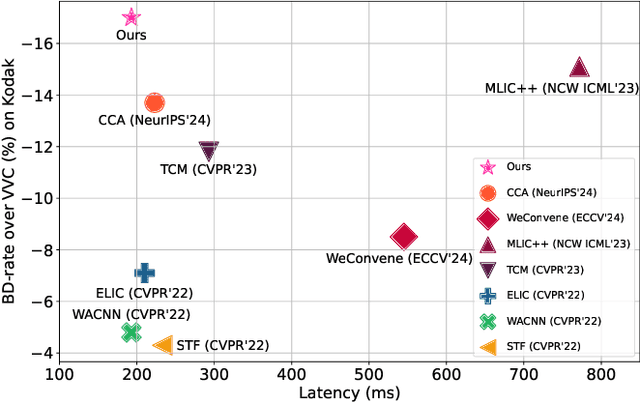
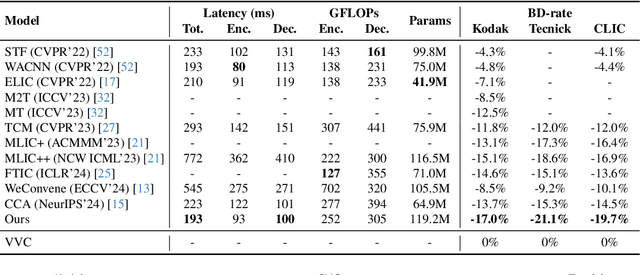


Abstract:Learned image compression methods have attracted great research interest and exhibited superior rate-distortion performance to the best classical image compression standards of the present. The entropy model plays a key role in learned image compression, which estimates the probability distribution of the latent representation for further entropy coding. Most existing methods employed hyper-prior and auto-regressive architectures to form their entropy models. However, they only aimed to explore the internal dependencies of latent representation while neglecting the importance of extracting prior from training data. In this work, we propose a novel entropy model named Dictionary-based Cross Attention Entropy model, which introduces a learnable dictionary to summarize the typical structures occurring in the training dataset to enhance the entropy model. Extensive experimental results have demonstrated that the proposed model strikes a better balance between performance and latency, achieving state-of-the-art results on various benchmark datasets.
ShiftLIC: Lightweight Learned Image Compression with Spatial-Channel Shift Operations
Mar 29, 2025Abstract:Learned Image Compression (LIC) has attracted considerable attention due to their outstanding rate-distortion (R-D) performance and flexibility. However, the substantial computational cost poses challenges for practical deployment. The issue of feature redundancy in LIC is rarely addressed. Our findings indicate that many features within the LIC backbone network exhibit similarities. This paper introduces ShiftLIC, a novel and efficient LIC framework that employs parameter-free shift operations to replace large-kernel convolutions, significantly reducing the model's computational burden and parameter count. Specifically, we propose the Spatial Shift Block (SSB), which combines shift operations with small-kernel convolutions to replace large-kernel. This approach maintains feature extraction efficiency while reducing both computational complexity and model size. To further enhance the representation capability in the channel dimension, we propose a channel attention module based on recursive feature fusion. This module enhances feature interaction while minimizing computational overhead. Additionally, we introduce an improved entropy model integrated with the SSB module, making the entropy estimation process more lightweight and thereby comprehensively reducing computational costs. Experimental results demonstrate that ShiftLIC outperforms leading compression methods, such as VVC Intra and GMM, in terms of computational cost, parameter count, and decoding latency. Additionally, ShiftLIC sets a new SOTA benchmark with a BD-rate gain per MACs/pixel of -102.6\%, showcasing its potential for practical deployment in resource-constrained environments. The code is released at https://github.com/baoyu2020/ShiftLIC.
Fg-T2M++: LLMs-Augmented Fine-Grained Text Driven Human Motion Generation
Feb 08, 2025Abstract:We address the challenging problem of fine-grained text-driven human motion generation. Existing works generate imprecise motions that fail to accurately capture relationships specified in text due to: (1) lack of effective text parsing for detailed semantic cues regarding body parts, (2) not fully modeling linguistic structures between words to comprehend text comprehensively. To tackle these limitations, we propose a novel fine-grained framework Fg-T2M++ that consists of: (1) an LLMs semantic parsing module to extract body part descriptions and semantics from text, (2) a hyperbolic text representation module to encode relational information between text units by embedding the syntactic dependency graph into hyperbolic space, and (3) a multi-modal fusion module to hierarchically fuse text and motion features. Extensive experiments on HumanML3D and KIT-ML datasets demonstrate that Fg-T2M++ outperforms SOTA methods, validating its ability to accurately generate motions adhering to comprehensive text semantics.
Learned Scanpaths Aid Blind Panoramic Video Quality Assessment
Mar 30, 2024Abstract:Panoramic videos have the advantage of providing an immersive and interactive viewing experience. Nevertheless, their spherical nature gives rise to various and uncertain user viewing behaviors, which poses significant challenges for panoramic video quality assessment (PVQA). In this work, we propose an end-to-end optimized, blind PVQA method with explicit modeling of user viewing patterns through visual scanpaths. Our method consists of two modules: a scanpath generator and a quality assessor. The scanpath generator is initially trained to predict future scanpaths by minimizing their expected code length and then jointly optimized with the quality assessor for quality prediction. Our blind PVQA method enables direct quality assessment of panoramic images by treating them as videos composed of identical frames. Experiments on three public panoramic image and video quality datasets, encompassing both synthetic and authentic distortions, validate the superiority of our blind PVQA model over existing methods.
Modular Blind Video Quality Assessment
Mar 13, 2024



Abstract:Blind video quality assessment (BVQA) plays a pivotal role in evaluating and improving the viewing experience of end-users across a wide range of video-based platforms and services. Contemporary deep learning-based models primarily analyze the video content in its aggressively downsampled format, while being blind to the impact of actual spatial resolution and frame rate on video quality. In this paper, we propose a modular BVQA model, and a method of training it to improve its modularity. Specifically, our model comprises a base quality predictor, a spatial rectifier, and a temporal rectifier, responding to the visual content and distortion, spatial resolution, and frame rate changes on video quality, respectively. During training, spatial and temporal rectifiers are dropped out with some probabilities so as to make the base quality predictor a standalone BVQA model, which should work better with the rectifiers. Extensive experiments on both professionally-generated content and user generated content video databases show that our quality model achieves superior or comparable performance to current methods. Furthermore, the modularity of our model offers a great opportunity to analyze existing video quality databases in terms of their spatial and temporal complexities. Last, our BVQA model is cost-effective to add other quality-relevant video attributes such as dynamic range and color gamut as additional rectifiers.
PreDiff: Precipitation Nowcasting with Latent Diffusion Models
Jul 19, 2023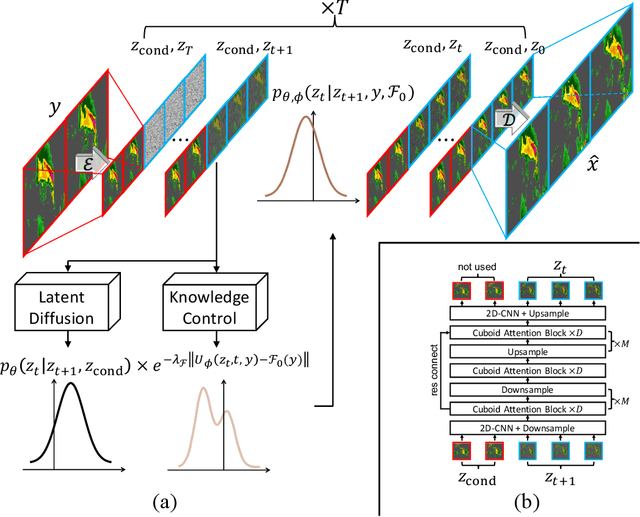
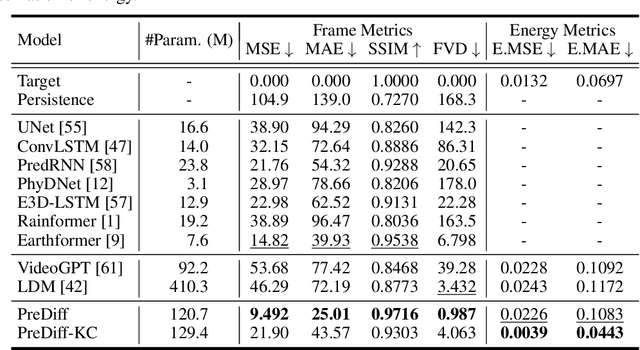
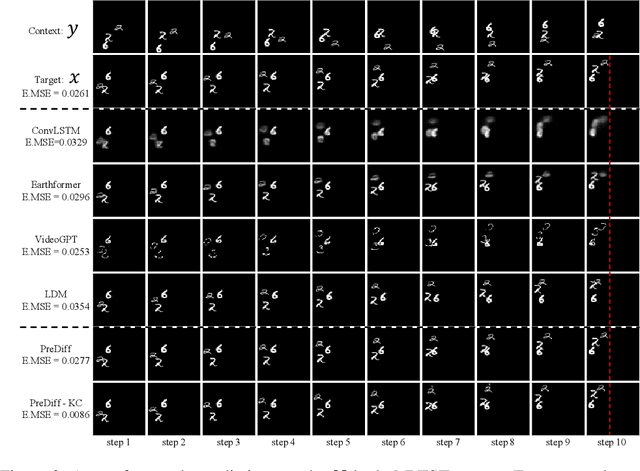
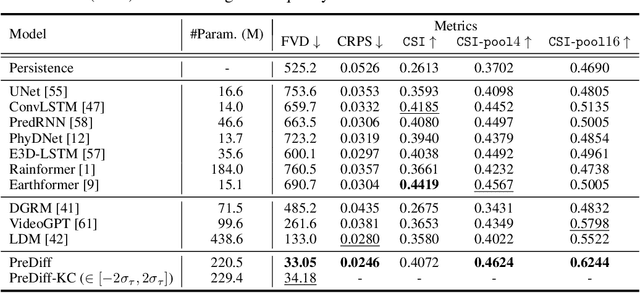
Abstract:Earth system forecasting has traditionally relied on complex physical models that are computationally expensive and require significant domain expertise. In the past decade, the unprecedented increase in spatiotemporal Earth observation data has enabled data-driven forecasting models using deep learning techniques. These models have shown promise for diverse Earth system forecasting tasks but either struggle with handling uncertainty or neglect domain-specific prior knowledge, resulting in averaging possible futures to blurred forecasts or generating physically implausible predictions. To address these limitations, we propose a two-stage pipeline for probabilistic spatiotemporal forecasting: 1) We develop PreDiff, a conditional latent diffusion model capable of probabilistic forecasts. 2) We incorporate an explicit knowledge control mechanism to align forecasts with domain-specific physical constraints. This is achieved by estimating the deviation from imposed constraints at each denoising step and adjusting the transition distribution accordingly. We conduct empirical studies on two datasets: N-body MNIST, a synthetic dataset with chaotic behavior, and SEVIR, a real-world precipitation nowcasting dataset. Specifically, we impose the law of conservation of energy in N-body MNIST and anticipated precipitation intensity in SEVIR. Experiments demonstrate the effectiveness of PreDiff in handling uncertainty, incorporating domain-specific prior knowledge, and generating forecasts that exhibit high operational utility.
Tailoring Instructions to Student's Learning Levels Boosts Knowledge Distillation
May 16, 2023



Abstract:It has been commonly observed that a teacher model with superior performance does not necessarily result in a stronger student, highlighting a discrepancy between current teacher training practices and effective knowledge transfer. In order to enhance the guidance of the teacher training process, we introduce the concept of distillation influence to determine the impact of distillation from each training sample on the student's generalization ability. In this paper, we propose Learning Good Teacher Matters (LGTM), an efficient training technique for incorporating distillation influence into the teacher's learning process. By prioritizing samples that are likely to enhance the student's generalization ability, our LGTM outperforms 10 common knowledge distillation baselines on 6 text classification tasks in the GLUE benchmark.
 Add to Chrome
Add to Chrome Add to Firefox
Add to Firefox Add to Edge
Add to Edge